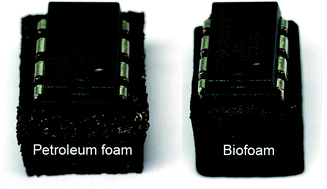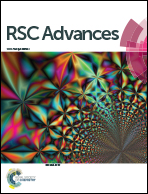Conductive biofoams of wheat gluten containing carbon nanotubes, carbon black or reduced graphene oxide†
Abstract
Conductive biofoams made from glycerol-plasticized wheat gluten (WGG) are presented as a potential substitute in electrical applications for conductive polymer foams from crude oil. The soft plasticised foams were prepared by conventional freeze-drying of wheat gluten suspensions with carbon nanotubes (CNTs), carbon black (CB) or reduced graphene oxide (rGO) as the conductive filler phase. The change in conductivity upon compression was documented and the results show not only that the CNT-filled foams show a conductivity two orders of magnitude higher than foams filled with the CB particles, but also that there is a significantly lower percolation threshold with percolation occurring already at 0.18 vol%. The rGO-filled foams gave a conductivity inferior to that obtained with the CNTs or CB particles, which is explained as being related to the sheet-like morphology of the rGO flakes. An increasing amount of conductive filler resulted in smaller pore sizes for both CNTs and CB particles due to their interference with the ice crystal formation before the lyophilization process. The conductive WGG foams with CNTs were fully elastic with up to 10% compressive strain, but with increasing compression up to 50% strain the recovery gradually decreased. The data show that the conductivity strongly depends on the type as well as the concentration of the conductive filler, and the conductivity data with different compressions applied to these biofoams are presented for the first time.



 Please wait while we load your content...
Please wait while we load your content...